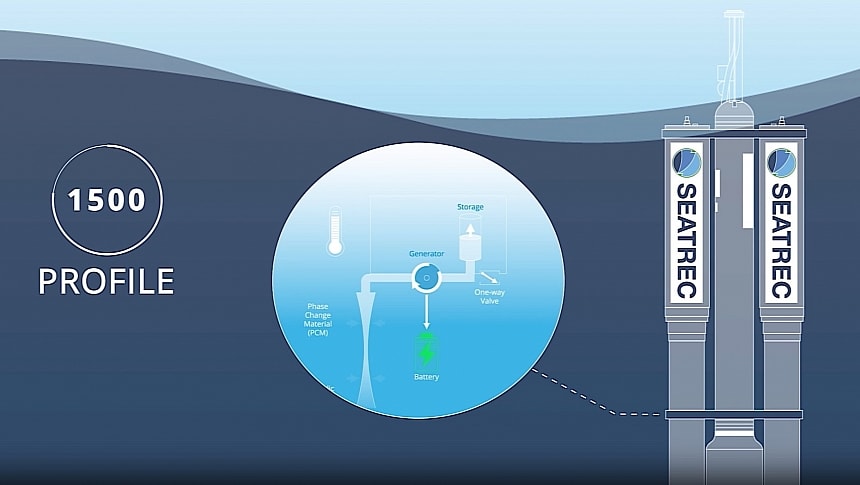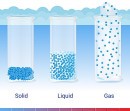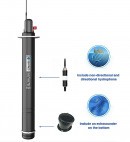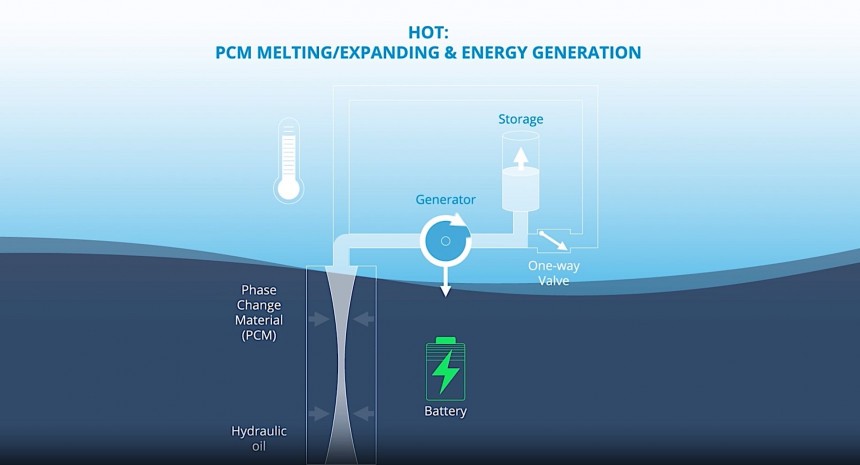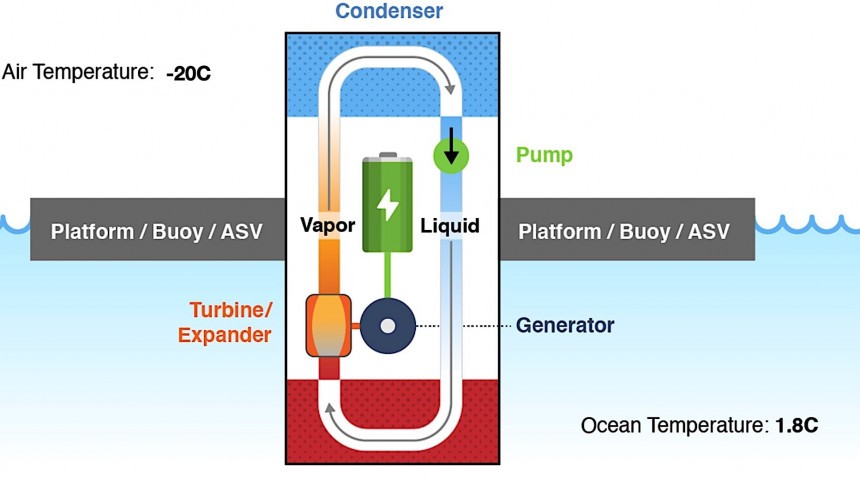We're constantly making strides to explore the space around our planet and in our galaxy, but the reality remains that we're not even close to completely knowing Earth itself. Did you know, for instance, that some 80 percent of the global seafloor is presently uncharted?
Mapping the ocean floor it is extremely difficult for a very simple reason: the place is too far away from the power of the Sun, thus unable to feed man-made objects, and the only way we know of to power the robots and sensors sent down there is to use batteries.
The trick with these batteries is that they don't last long, and they're nearly impossible to charge because of their location on the seafloor. That, in turn, not only makes undersea exploration extremely costly, but also highly polluting, as most of these robots and sensors are abandoned there once their batteries die out.
Estimates say there are presently some 4,000 robotic sensors submerged in the waters of the world for various reasons, with around 1,000 of them dying out each year on account of depleted batteries.
For a while NASA has been sitting on something that may prove the perfect solution for all those (and potentially more) problems: a battery that can be powered entirely by its environment, indefinitely, and requires no human. That may sound a bit too good to be true, but it is real.
The concept of a battery that can be charged forever relies on something called phase-change materials. Those would be elements that transition between solid, liquid, and gaseous phases, generating kinetic energy from volume expansion in the process.
Technically, that would be most substances on this Earth, as with the exception of water and some metals, they all expand when they melt and contract when they freeze. Such stuff is already used by NASA to allow its spacecraft to better handle the extreme temperatures of space.
To be fair, humans have been using phase-change materials since forever, it seems. Take the steam engine, for instance. The thing uses water's expansion into steam to turn a motor, which moves a vehicle.
The exact same concept of volume expansion can be used to turn a motor that converts mechanical energy into electricity, which can later be stored in a battery.
It was this idea that prompted a NASA scientist by the name Yi Chao and two of his colleagues from the Jet Propulsion Laboratory into developing a piece of technology that could really open up underwater exploration.
Chao was involved in NASA's Aquarius mission, a satellite launched in 2011 to study the salinity of the oceans by getting data from sensors in the water. On an official level, the mission was a success, "giving climatologists a better understanding of the ocean's role in Earth's water cycle and weather patterns."
However, the way sensor batteries prevented the mission from achieving more gave Chao the idea to use phase-change materials as a potential source of never-ending power.
For the task at hand he chose a paraffin-family substance that melts at about 50 degrees Fahrenheit (ten degrees Celsius), placing it right between deep-ocean and surface temperatures (40°F / 4.4°C deep down, 70°F / 21°C on the surface).
Subsea sensors and robots need to regularly climb back up to send their data, and they often go back down to continue their mission. In doing so, they pass through various ocean temperatures, which affect the paraffin substance: it melts and expands, generating a small amount of kinetic energy in doing so.
The idea works, and even if the expansion brought from the transformation from solid to liquid is only ten percent, proper engineering of a device can harness that energy. And it can do that indefinitely, or at least for as long as the sensor or robot moves up and down in the ocean, taking advantage of the water temperature changes.
And that's exactly what Chao and his team proved in 2011, when they built a prototype float and an underwater glider powered by this technology. The idea caught on, so the tech was licensed and a company meant to oversee its production was created: Seatrec.
Seatrec is presently selling such an endless power source in the form of a module called SL1. It's already being used by labs, universities, governments, and the U.S. Navy, but not extensively. Yet.
In the not so distant future, the company plans to start selling a system to power underwater gliders. A power station that "would cycle a liquid-to-gas phase-change material through ocean depths, creating an order of magnitude more energy" is also on the agenda, as a potential power source for larger robots.
The U.S. Navy, on the other hand, funded Seatrec to deploy a power station in the Arctic, in bid to prove the same process of generating power can be replicated by taking advantage of the difference between water and air temperatures.
In essence, says the man with the idea, "anywhere you have a temperature difference, we can turn that into electricity," and the implications for that are huge. Only time will tell if we have what it takes to make the most of this idea.
The trick with these batteries is that they don't last long, and they're nearly impossible to charge because of their location on the seafloor. That, in turn, not only makes undersea exploration extremely costly, but also highly polluting, as most of these robots and sensors are abandoned there once their batteries die out.
Estimates say there are presently some 4,000 robotic sensors submerged in the waters of the world for various reasons, with around 1,000 of them dying out each year on account of depleted batteries.
For a while NASA has been sitting on something that may prove the perfect solution for all those (and potentially more) problems: a battery that can be powered entirely by its environment, indefinitely, and requires no human. That may sound a bit too good to be true, but it is real.
The concept of a battery that can be charged forever relies on something called phase-change materials. Those would be elements that transition between solid, liquid, and gaseous phases, generating kinetic energy from volume expansion in the process.
Technically, that would be most substances on this Earth, as with the exception of water and some metals, they all expand when they melt and contract when they freeze. Such stuff is already used by NASA to allow its spacecraft to better handle the extreme temperatures of space.
The exact same concept of volume expansion can be used to turn a motor that converts mechanical energy into electricity, which can later be stored in a battery.
It was this idea that prompted a NASA scientist by the name Yi Chao and two of his colleagues from the Jet Propulsion Laboratory into developing a piece of technology that could really open up underwater exploration.
Chao was involved in NASA's Aquarius mission, a satellite launched in 2011 to study the salinity of the oceans by getting data from sensors in the water. On an official level, the mission was a success, "giving climatologists a better understanding of the ocean's role in Earth's water cycle and weather patterns."
However, the way sensor batteries prevented the mission from achieving more gave Chao the idea to use phase-change materials as a potential source of never-ending power.
For the task at hand he chose a paraffin-family substance that melts at about 50 degrees Fahrenheit (ten degrees Celsius), placing it right between deep-ocean and surface temperatures (40°F / 4.4°C deep down, 70°F / 21°C on the surface).
Subsea sensors and robots need to regularly climb back up to send their data, and they often go back down to continue their mission. In doing so, they pass through various ocean temperatures, which affect the paraffin substance: it melts and expands, generating a small amount of kinetic energy in doing so.
And that's exactly what Chao and his team proved in 2011, when they built a prototype float and an underwater glider powered by this technology. The idea caught on, so the tech was licensed and a company meant to oversee its production was created: Seatrec.
Seatrec is presently selling such an endless power source in the form of a module called SL1. It's already being used by labs, universities, governments, and the U.S. Navy, but not extensively. Yet.
In the not so distant future, the company plans to start selling a system to power underwater gliders. A power station that "would cycle a liquid-to-gas phase-change material through ocean depths, creating an order of magnitude more energy" is also on the agenda, as a potential power source for larger robots.
The U.S. Navy, on the other hand, funded Seatrec to deploy a power station in the Arctic, in bid to prove the same process of generating power can be replicated by taking advantage of the difference between water and air temperatures.
In essence, says the man with the idea, "anywhere you have a temperature difference, we can turn that into electricity," and the implications for that are huge. Only time will tell if we have what it takes to make the most of this idea.
